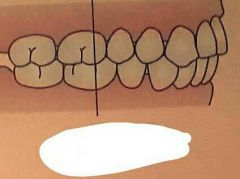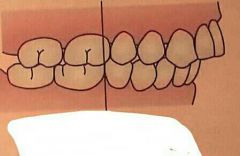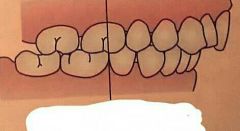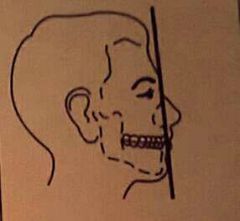![]()
![]()
![]()
Use LEFT and RIGHT arrow keys to navigate between flashcards;
Use UP and DOWN arrow keys to flip the card;
H to show hint;
A reads text to speech;
79 Cards in this Set
- Front
- Back
|
At how many weeks of pregnancy does the primary face and mouth form? |
4 weeks |
|
|
At how many weeks of pregnancy does tooth buds N-Q form? |
5-6 weeks |
|
|
At how many weeks of pregnancy does the face start to develop? |
5-8 weeks |
|
|
At how many weeks of pregnancy does tooth buds 23-26 start to form? |
17 weeks |
|
|
By birth (40 weeks) how many tooth buds in various stages are formed in the jaws? |
44 tooth buds |
|
|
At 6 months old, what teeth start to develop? |
2, 15, 18, and 31 |
|
|
At 7 years old what teeth start to develop? |
1, 16, 17, and 32 |
|
|
At what age are all roots fully developed? |
22 years old |
|
|
What is the first 3 steps in the process of primary tooth development? |
1. Each tooth starts as one microscopic cell 2. Tooth's cell undergoes cellular division and there are more tooth cells 3. This developing tooth causes pressure on the surrounding jawbone |
|
|
What are 4th, 5th, and 6th steps in the process of primary tooth development? |
4. This pressure stimulates jawbone to produce osteoclasts to resort the jawbone around the the developing primary tooth to reduce the pressure that the developing tooth is putting on the jawbone. 5. Now there's room around developing tooth so tooth cells divide and multiply more. More primary tooth is formed. Causes pressure on bone. 6. Cycle of grow, pressure, resorb continues. Tooth ways developing towards gingiva. As tooth is forming ameloblasts, odontoblasts, and Cementoblasts form parts of tooth. |
|
|
What is the cycle to create a primary tooth? |
Grow, pressure, resorb |
|
|
What are the last steps in the primary tooth development? |
7. Cycle continues until whole anatomical crown is formed and half root is formed. At this time tooth is right under gingiva. 8. Cusps and mamelons are putting pressure on underside of gingiva. Gingiva produces fibroblasts to resorb the gingiva so gingiva is relieved of pressure and does not tear as tooth erupts. 9. Tooth erupts! 10. Primary tooth continues to erupt as root forms. Remaining half of tooth development pushes whole tooth into oral cavity. -occlusion occurs which stops the supraeruption from overoccurring |
|
|
What age do the primary mandibular central incisors erupt? |
6 months |
|
|
What age does the primary mandibular lateral incisors erupt? |
7 months |
|
|
What age do the primary maxillary central laterals erupt? |
7 1/2 months |
|
|
What age do the primary maxillary lateral incisors erupt? |
9 months |
|
|
At what age do all primary first molars erupt? |
1 year |
|
|
At what age do all primary canines erupt? |
18 months |
|
|
At what age do all primary second molars erupt? |
2 years |
|
|
What guides teeth? |
Roots |
|
|
What 2 pressures cause the primary tooth resorb? |
1. Chewing stress causes occlusal/incisal pressure 2. Permanent tooth development caused apical pressure |
|
|
Where do the permanent anterior teeth develop? |
At the apex of the primary anterior teeth |
|
|
Where do the premolars form? |
Between the roots of the primary molars |
|
|
What stimulates resorbers? |
Permanent developing tooth, it's roots, and PDL |
|
|
How does resorption occur? |
1. Osteoclasts to resorb bone around the permanent teeth 2. Cementoblasts resorb the cementum in the primary roots 3. Odontoblasts resorb dentin in the primary roots 4. The blood and nerve tissue in pulp just stops growing |
|
|
Where do the primary root cells go in resorption? |
Blood stream |
|
|
When the permanent tooth's whole anatomical crown is formed how much of the root is formed? |
Half of root |
|
|
The root in the permanent tooth's continues to form while what is happening? |
The permanent tooth's continues to erupt |
|
|
What actually pushes the whole tooth into the oral cavity? |
Remaining half of root development |
|
|
What stops supraeruption from occuring? |
Occlusion |
|
|
Define anomalies |
Something noticeable different or deviates from norm. Enamel, dentin, and cementum deviation |
|
|
What is a contact? |
A tooth touches the tooth next to it |
|
|
What are the functions of contact? |
1. Prevent trapped food 2. Stabilizes the arch 3. Gingival tissue protection |
|
|
What does interproximal mean? |
Between the adjacent teeth |
|
|
What is the contour of teeth? |
Teeth are curved, narrow at CEJ. Not square, rectangle, or flat |
|
|
What is the function of contour? |
1. Aids in self cleaning of teeth, food slides off 2. Protects the gingiva |
|
|
What is an Embrasure? |
A "v" shaped interproximal area, formed below the contact |
|
|
What is the function of the embrasure? |
Holds the gingival papilla |
|
|
What is overjet? |
When the teeth occluded the maxillary arch horizontally overlaps the mandibular arch |
|
|
What is overbite? |
When the teeth occluded the maxillary arch vertically overlaps the mandibular arch |
|
|
What is underbite? |
Mandibular arch extends forward beyond maxillary arch |
|
|
What are the 3 facial profiles? |
Mesogathic, retrogathic, and prognathic |
|
|
What is mesognathic? |
Straight or flat facial profile |
|
|
What is retrognathic? |
Over developed maxillary and under developed mandibular |
|
|
What is prognathic? |
Over developed mandibular and under developed maxillary |
|
|
Class 1 malocclusion |
MB cusp of maxillary first molar occluded with MB groove of mandibular first molar |
|
|
What is open bite? |
When anterior teeth don't touch |
|
|
What is crossbite? |
Mandibular tooth or teeth are placed facial to maxillary teeth |
|
|
What is class II malocclusion? |
Distoclusion, MB cusp of maxillary first molar occluding (by more than width of premolar) medial to the MB groove of mandibular first molar |
|
|
What is class II malocclusion division I? |
-Maxillary anterior protrude facially from mandibular anterior -Mandibular incisors usually overerupt, causing severe overbite |
|
|
What is class II malocclusion division II? |
-prognathic -Maxillary central incisors are either upright or retruded -Maxillary lateral incisors are either tipped labially or they overlap central incisors -overbite is severe |
|
|
What is class III malocclusion? |
MB cusp of maxillary first molar occludes (by more than width of premolar) distal to MB groove of mandibular first molar. -Mandibular incisors in complete crossbite |
|

|
Class I |
|

|
Class II Division 1 |
|

|
Class II Division 2 |
|

|
Class III |
|

|
Mesognathic |
|

|
Retrognathic |
|

|
Prognathic |
|
|
What teeth are bifurcated? |
-All mandibular molars -Maxillary first premolars
|
|
|
What teeth are trifurcated? |
-All maxillary molars |
|
|
What is a cusp? |
Pointed part of enamel on occlusal surface or cusp on an incisal edge |
|
|
How many Cusps do molars have? |
4-5 cusps |
|
|
How many Cusps do premolars have? |
2-3 cusps |
|
|
How many Cusps do canines have? |
1 cusp |
|
|
What's a mamelon? |
3 points of enamel on incisal edge of newly erupted incisors |
|
|
What is a groove? |
Linear depression on the O, B, and L surfaces of posterior teeth |
|
|
What is a fissure? |
Fault on a groove where enamel is not properly formed |
|
|
What is a pit? |
Small deep depression where fissures meet |
|
|
What is the marginal ridge? |
Forms the m and d sides of posterior teeth |
|
|
What is the oblique ridge? |
Runs diagonally across maxillary molars |
|
|
What is the transverse ridge? |
Runs straight across the O surface of molars |
|
|
What is the incisal ridge? |
Edge of the incisors before mamelons are worn away |
|
|
What is a Cingulum? |
Bump of enamel on the cervical 1/3 of the anterior teeth |
|
|
What tooth has the longest root? |
Maxillary canine |
|
|
What teeth are frequently missing? |
Maxillary lateral incisors and mandibular 2nd premolars and all third molars |
|
|
What is the largest tooth? |
Maxillary first molar |
|
|
Where do anomalies most likely occur? |
-Maxillary lateral incisors -3rd molars |
|
|
What is the extra cusp on the ML cusp on 3 and 14 called? |
Cusp of Carabelli |

